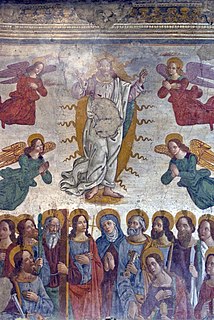Andrea da Murano, also known as Andrea di Giovanni (active 1463 to 1502) was an Italian painter, active mainly in Venice and the Venetian mainland.

Andrea da Murano, also known as Andrea di Giovanni (active 1463 to 1502) was an Italian painter, active mainly in Venice and the Venetian mainland.

In 1468, he was given, along with Bartolomeo Vivarini, a commission for painting a canvas for the Scuola di San Marco. In 1472, he is known to have had a studio with his brother, the engraver Girolamo, located in the neighborhood of Santa Maria Formosa. He painted an altarpiece for the church of Santa Maria di Trebaseleghe in Treviso. In 1499, he was living in Castelfranco. In 1502 he painted an altarpiece for the parish church of Mussolente in the province of Vicenza.
A triptych depicting Saints Sebastian, Vincent Ferrer, Roch, and four others with St Peter and the Madonna della Misericordia (1475) is attributed to Andrea and found in the Gallerie dell'Accademia of Venice, deriving from the church of San Pietro Martire of Murano. [1]

Lorenzo Lotto was an Italian painter, draughtsman, and illustrator, traditionally placed in the Venetian school, though much of his career was spent in other north Italian cities. He painted mainly altarpieces, religious subjects and portraits. He was active during the High Renaissance and the first half of the Mannerist period, but his work maintained a generally similar High Renaissance style throughout his career, although his nervous and eccentric posings and distortions represented a transitional stage to the Florentine and Roman Mannerists.

Raffaellino del Garbo was a Florentine painter of the early Renaissance.

Vivarini is the surname of a family of painters from Murano (Venice), who produced a great quantity of work in Venice and its neighborhood in the 15th century, leading on to that phase of the school which is represented by Carpaccio and the Bellini family.

The Pesaro Madonna is a painting by the late Italian Renaissance master Titian, commissioned by Jacopo Pesaro, whose family acquired in 1518 the chapel in the Frari Basilica in Venice for which the work was painted, and where it remains today. Jacopo was Bishop of Paphos, in Cyprus, and had been named commander of the papal fleet by the Borgia pope, Alexander VI. This painting recalls one of Titian's earliest paintings Jacopo Pesaro being presented by Pope Alexander VI to Saint Peter, c. 1510-11

Alessandro Turchi was an Italian painter of the early Baroque, born and active mainly in Verona, and moving late in life to Rome. He also went by the name Alessandro Veronese or the nickname L'Orbetto. His style has been described as soft and Caravaggesque at the same time.
Giovanni Odazzi was an Italian painter and etcher of the Baroque period, active mainly in Rome.

Francesco Rizzo da Santacroce, also known as simply Francesco da Santacroce or Francesco di Bernardo de' Vecchi Da Santa Croce was an Italian painter of the Renaissance period, active mainly in Bergamo and Venice.

Pietro Dandini was an Italian painter of the Baroque period, active mainly in Florence.
The decade of the 1440s in art involved some significant events.

Ludovico Gimignani was an Italian painter, who is mainly known for his altarpieces for churches in Rome.

Filippo Abbiati (1640–1715) was an Italian painter of the early-Baroque period, active in Lombardy and Turin, together with Andrea Lanzani and Stefano Maria Legnani, he was a prominent mannerist painters from the School of Lombardy. Born in Milan, he was a pupil of the painter Antonio Busca. Alessandro Magnasco was one of his pupils along with Pietro Maggi and Giuseppe Rivola. Ticozzi claims he trained, along with Federigo Bianchi, with Carlo Francesco Nuvolone. Along with Bianchi, he painted the cupola of Sant'Alessandro Martire in Milan. Abbiati also painted a St. John preaching in the Wilderness for a church in Saronno.

Giovanni Giacomo Barbelli was an Italian painter of the Baroque period, active in Lombardy. He was a canvas and fresco painter known for his religious and mythological scenes that decorate many churches and residences in Lombardy. He was a highly skilled draughtsman and a brilliant colorist. His work shows an inventive imagination and a thorough knowledge of perspective.

Giuseppe Tortelli was an Italian painter of the late Baroque period, active in Brescia.
Giovanni Battista Buonocore was an Italian painter of the Baroque period. He became Rector (1679), then Principe (1698) of the Accademia di San Luca of Rome.

San Pietro Martire is a Roman catholic parish church in Murano, near Venice, northern Italy.

Giovanni Agostino da Lodi was an Italian painter who was active from c. 1495 to c. 1525.

Cosroe Dusi was an Italian painter in the Neoclassical style, active for many years in St Petersburg, Russia, painting mainly sacred and historical subjects. Dusi was nicknamed by his contemporaries the "modern Tintoretto", for his liveliness of invention and rapidity at painting.
Giovanni Battista Belloti was an Italian painter of the Baroque style, active mainly in Verona.

The Barbarigo Altarpiece or Enthroned Madonna and Child with Angel Musicians and Saint Mark, Saint Augustine and Doge Agostino Barbarigo is a 1488 oil painting on panel by Giovanni Bellini, now in the church of San Pietro Martire in Murano.

Filippo di Antonio Filippelli (1460–1506) was an Italian Renaissance in Tuscany.
| Wikimedia Commons has media related to Andrea da Murano . |